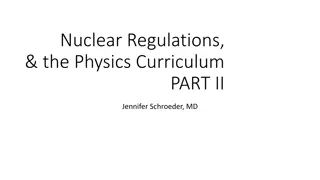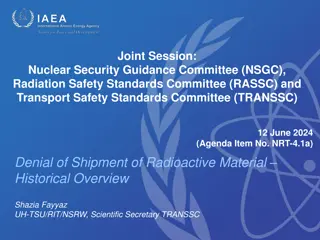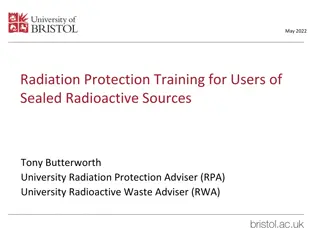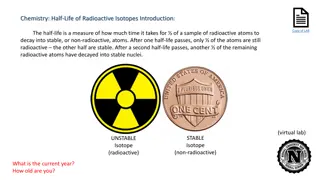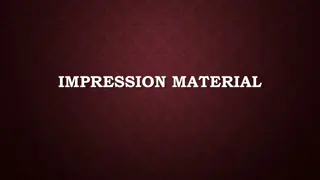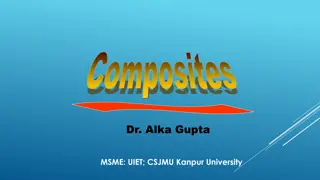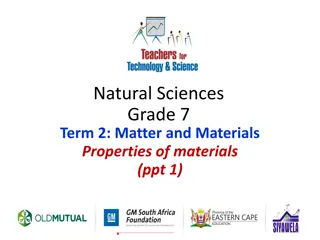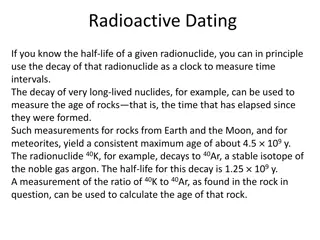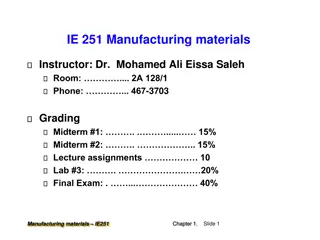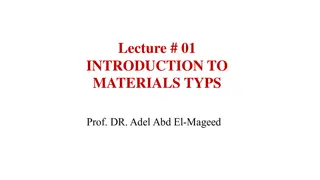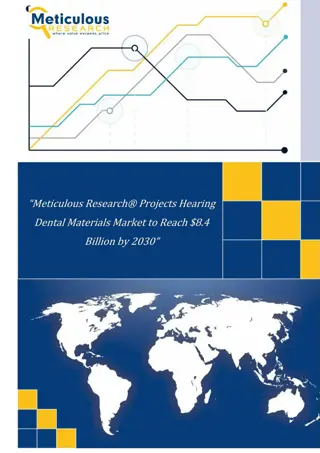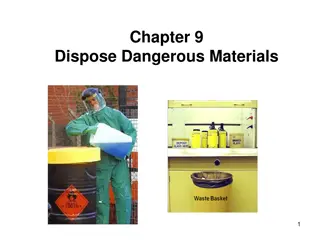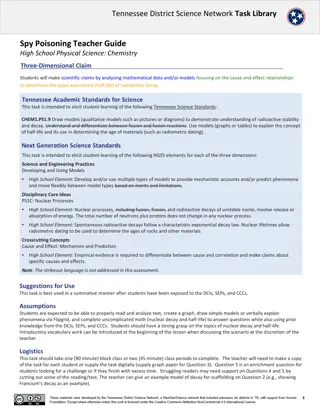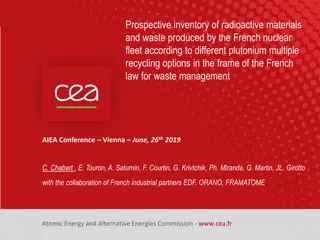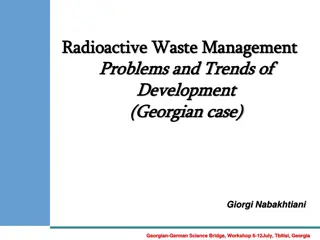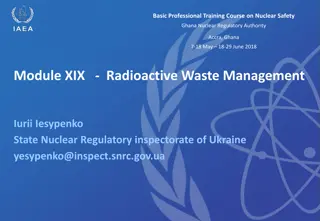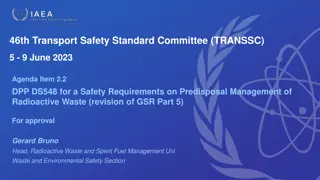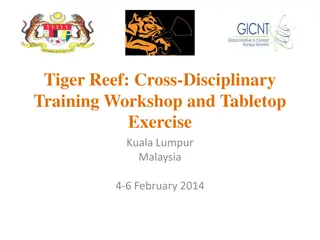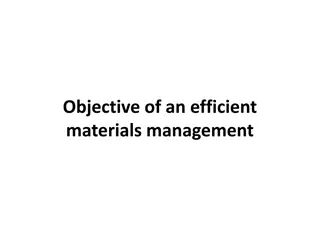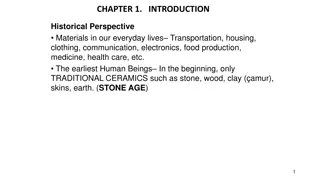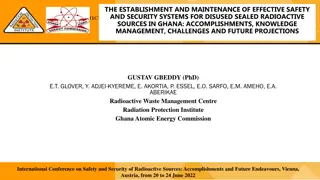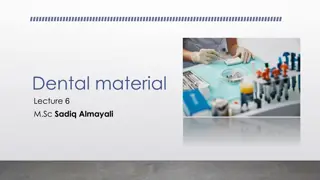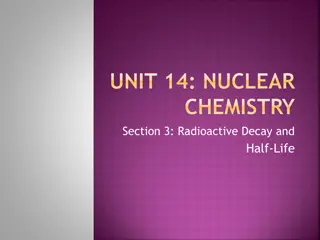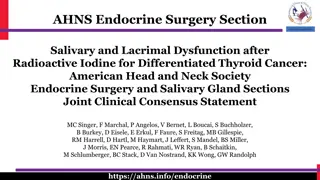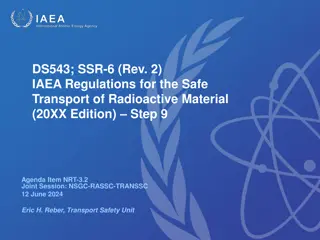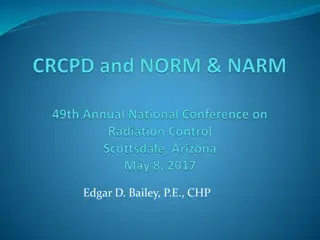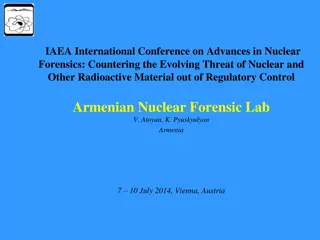Best Practices for Handling Radioactive Spills in Nuclear Medicine Facilities
Understanding the guidelines for dealing with radioactive spills is crucial in nuclear medicine. This comprehensive guide covers major and minor spill scenarios, steps to take in case of a spill, and special considerations for radioactive gas spills. Learn how to ensure safety, prevent contamination
1 views • 34 slides
Understanding Radioactive Decay and Nuclear Radiation
Radioactive decay is the process in which unstable atomic nuclei emit charged particles and energy, transforming into different elements. This process involves the emission of alpha particles, beta particles, and gamma rays. Alpha particles consist of two protons and two neutrons, beta particles are
4 views • 31 slides
Understanding Half-Life in Physics
Half-life is a key concept in physics, particularly in radioactive decay. It is the time taken for the activity of a radioactive source to decrease to half of its original value. This can be determined experimentally through measuring counts per minute and graphing the data. Additionally, half-life
2 views • 11 slides
National Radioactive Waste Management Plan Overview
Briefing the Select Committee on Land Reform, Environment, Mineral Resources, and Energy about the South African Radioactive Waste Management Programme and the legislative background governing radioactive waste management. The presentation outlines the framework, guiding elements, waste management p
4 views • 19 slides
Evolution of Radiopharmacy: A Specialized Field in Pharmacy
The evolution of radiopharmacy as a specialty has progressed rapidly since the 1950s, involving the preparation, dispensing, and clinical investigation of radioactive materials as drugs. Radiopharmacy plays a crucial role in the development and use of radiopharmaceuticals for diagnostic, therapeutic
3 views • 53 slides
Overview of Denial of Shipment of Radioactive Material in NSGC, RASSC, & TRANSSC Joint Session
The Joint Session held by the NSGC, RASSC, and TRANSSC on June 12, 2024, discussed the historical overview and implications of denying shipments of radioactive material. It highlighted the importance of coordination with UN organizations and industry groups in ensuring the safe transport of such mat
1 views • 7 slides
Significance of Raw Materials in Food Processing
Effective selection of raw materials is crucial for ensuring the quality of processed food products. The quality of raw materials directly impacts the final products, making it important to procure materials that align closely with processing requirements. Quality evaluation, including microbiologic
2 views • 30 slides
Radiation Protection Training for Users of Sealed Radioactive Sources - May 2022
This document provides radiation protection training tailored for users of sealed radioactive sources, ensuring compliance with legislative requirements and university policies. The training covers topics such as ionising radiation, effects of exposure, monitoring requirements, and more. All trainin
0 views • 81 slides
Exploring Radioactive Decay: A Half-Life Lab Simulation
Explore the concept of radioactive decay through a virtual lab simulation involving strontium-90 (Sr-90) and yttrium-90 (Y-90) isotopes. Witness the decay process over multiple half-lives as unstable atoms transform into stable nuclei. Dive into the intricacies of half-life measurements and the vast
0 views • 10 slides
Understanding Dental Impression Materials and Techniques
Dental impression materials are essential in dentistry to create precise negative records of the oral tissues. The process involves obtaining a negative impression and then producing a positive reproduction using materials like dental stone. These materials must meet specific desirable properties to
1 views • 18 slides
Understanding Composite Materials: Properties and Applications
Composite materials are combinations of chemically distinct substances that offer improved properties over individual materials. They can be natural or synthetic, with examples like wood and bamboo. Composites consist of reinforcing fibers or particles embedded in a matrix material. Smart materials,
1 views • 9 slides
Understanding Physical Properties of Materials in Grade 7 Natural Sciences
Exploring the physical properties of materials like strength and flexibility helps us decide which materials to use for specific purposes. Strong materials like steel and concrete are used in construction, while flexible materials like rubber and copper wire have different applications. Consideratio
1 views • 17 slides
Understanding Radioactive Dating Methods
The process of radioactive dating involves utilizing the decay of radionuclides to measure time intervals, with applications in determining the age of rocks and artifacts. Techniques such as radiocarbon dating, based on isotopes like 14C, enable scientists to determine the age of organic materials b
0 views • 4 slides
Materials Science: Revolutionizing Innovation in the Next Decade
Materials science is poised to be the cornerstone of technological advancements in the next decade, addressing challenges such as clean energy, product innovation, and material supply disruptions. Scientists are leveraging advanced simulation techniques and machine learning to accelerate materials r
2 views • 15 slides
IE 251 Manufacturing Materials Course Overview
Explore the impact of modern materials on daily products, understand engineering materials and their properties, and delve into classes of materials like metals, polymers, ceramics, and composites. The course covers topics ranging from atomic structure to phase transformations, emphasizing the role
0 views • 14 slides
Understanding Materials Science and Engineering Fundamentals
Materials play a crucial role in our daily lives, influencing everything from transportation to communication. This lecture delves into the historical significance of materials, the distinctions between materials science and materials engineering, and the importance of structure-property correlation
0 views • 25 slides
Exploring Materials in Everyday Objects
Discover the suitability of different materials for specific uses through fun activities like a spoon race with various spoon materials. Explore why certain materials are not appropriate for certain objects and engage in creative tasks like imagining a spoon made of tissue paper. Michael Rosen's whi
0 views • 6 slides
Dental Materials Market
The dental materials market is categorized based on type\u2014comprising Indirect Restorative Materials (metal-ceramics, ceramics, and other indirect materials), Direct Restorative Materials (amalgam, resin-based composites, glass ionomer, and other
0 views • 4 slides
Proper Disposal of Dangerous Chemical Waste in Laboratories
When disposing of dangerous materials in laboratories, it is crucial to follow established waste handling procedures to ensure safety and compliance. This includes using waste bottles provided by instructors, avoiding pouring substances down drains, and storing and labeling containers properly. Chem
0 views • 12 slides
Investigating Agent Z's Poisoning: A Case of Radioactive Decay
Agent Z, a double spy, was poisoned with Polonium-210, a heavy, radioactive element. This task challenges students to analyze the cause of his death using concepts of nuclear decay and half-life modeling based on provided data and models. The scenario involves understanding the effects of radioactiv
0 views • 14 slides
Prospective Inventory of Radioactive Materials and Waste Management Study in French Nuclear Fleet
The study conducted by the French Atomic Energy Commission in collaboration with industrial partners like EDF, Orano, and Framatome explores different plutonium recycling options in the French nuclear fleet. It assesses scenarios involving open cycle, mono-recycling, and multiple recycling of pluton
0 views • 16 slides
Understanding Raw Materials in Ceramic Production
Raw materials play a crucial role in ceramic production, with three main groups identified - plastic materials like clay, non-plastic or leading mixtures such as silica, and fluxes/mineralizers like feldspar. These materials undergo various transformations during the manufacturing process, contribut
0 views • 29 slides
CUIMC Laboratory Door Sign Generator Information
The CUIMC Laboratory Door Sign Generator provides instructions for creating door signs for CUIMC 4 x 4 door sign holders. It includes guidelines for different materials used in laboratories and contact information for specific signage needs. The tool offers pre-made text boxes and pictograms to cust
0 views • 8 slides
Understanding Source Term Assessment in Severe Nuclear Accidents
Delve into the complexities of source term assessment under severe accidents conditions, focusing on core degradation, containment pressure buildup, radioactive species release, safety systems, iodine-related phenomenology, and assessing the radioactive source term's impact on the environment. This
0 views • 21 slides
Challenges in Radioactive Waste Management: A Case Study of Georgian-German Science Collaboration
This document delves into the management of radioactive waste, highlighting the problems, trends, and development in the Georgian context. It explores the principles set by the IAEA for waste management, emphasizing the protection of human health, environment, and future generations. The discussion
0 views • 21 slides
Understanding Radioactive Decay and Isotopes in Chemistry
Explore the fascinating world of radioactive decay, isotopes, and nuclear transformations in this educational resource. From reviewing atomic numbers to illustrating alpha and beta decay processes, discover the fundamental principles behind these phenomena with detailed explanations and visuals. Del
0 views • 17 slides
Understanding X-Ray Diffraction Techniques in Materials Science
X-ray diffraction (XRD) analysis is a crucial technique in materials science for determining the crystallographic structure of materials. By irradiating a material with X-rays and measuring their intensities and scattering angles, XRD helps identify materials based on diffraction patterns. This meth
0 views • 5 slides
Comprehensive Module on Radioactive Waste Management in Nuclear Safety Training
This module XIX on Radioactive Waste Management explores the generation, classification, treatment, storage, and disposal processes of radioactive waste. It covers the nature and sources of radioactive waste in medical, industrial, and research settings. The module also delves into the regulatory co
0 views • 106 slides
Revision of Safety Requirements for Predisposal Management of Radioactive Waste at 46th TRANSSC
The 46th Transport Safety Standard Committee addresses the revision of GSR Part 5 concerning the predisposal management of radioactive waste. This update aims to harmonize safety requirements with current standards and establish protocols for the safe handling of all types of radioactive waste. The
0 views • 17 slides
Cross-Disciplinary Training Workshop on Radioactive Materials Incident Response
Emphasizing the importance of communication and cooperation between different communities, the Tiger Reef workshop in Kuala Lumpur focused on enhancing capabilities to manage incidents involving radioactive materials. With participants from 21 countries, the workshop aimed to bridge gaps in SOPs, co
0 views • 15 slides
Efficient Materials Management Strategies for Optimal Operations
Efficient materials management aims to ensure the right materials are available at the right place, time, quantity, and quality. It involves stages such as precise objective definition, specification of requirements, and measurement of performance. Factors influencing materials management include te
0 views • 20 slides
Understanding Types of Language Teaching Materials
Explore the various types of language teaching materials, including authentic and non-authentic materials, pedagogical resources, and created materials. Learn about the characteristics of authentic material and its advantages in language learning. Discover examples of authentic materials such as son
0 views • 22 slides
Evolution of Materials Science and Engineering in Human History
Explore the journey of materials in human history, from traditional ceramics to high-tech metal industry and beyond. Learn about the development of materials science and engineering, the different properties of materials, and the classification of materials into metals, ceramics, polymers, composite
0 views • 9 slides
Effective Safety and Security Systems for Disused Sealed Radioactive Sources in Ghana
Ghana has benefited from the peaceful use of sealed radioactive sources in various sectors. The establishment of safety measures, security systems, and knowledge management for disused sealed radioactive sources (DSRS) is crucial. Challenges and future projections in this area are discussed, emphasi
0 views • 15 slides
Understanding Rheology in Dental Materials
Rheology is a crucial aspect in dentistry as it deals with the flow properties of various dental materials, including liquids like molten alloy and impression materials. Viscosity plays a key role, determining how materials flow and behave. Different fluid classifications based on rheology, such as
0 views • 15 slides
Understanding Radioactive Decay and Half-Life in Nuclear Chemistry
Exploring the concept of radioactive decay and half-life in nuclear chemistry, this content covers the types of nuclear radiation, alpha decay of Uranium, and the significance of half-life in determining the decay of radioactive substances such as Carbon-14. An example with Fluorine-18 illustrates t
0 views • 9 slides
Salivary and Lacrimal Dysfunction after Radioactive Iodine Treatment
Radioactive iodine (RAI) is commonly used in treating differentiated thyroid cancer but can lead to salivary and lacrimal dysfunction. This joint clinical consensus statement by the American Head and Neck Society Endocrine Surgery and Salivary Gland Sections highlights the importance of understandin
0 views • 20 slides
International Regulatory Framework for Radioactive Material Transport Safety
SSR-6 (Rev.1) establishes safety requirements for transporting radioactive material to protect people and the environment from ionizing radiation. The framework applies globally across land, water, and air transport modes, involving operations and conditions related to radioactive material movement.
0 views • 24 slides
Regulatory Evolution of Radioactive Materials Licensing
The regulatory landscape surrounding Naturally Occurring and Accelerator-Produced Radioactive Materials (NARM) underwent significant changes in the 20th century. Various entities, including AEC/NRC and states, grappled with the regulation of NARM, leading to a lack of consistency. Initiatives such a
0 views • 17 slides
Challenges and Solutions in Protecting Radioactive Sources in Post-USSR Armenia
The collapse of the USSR presented Armenia with challenges in managing radioactive materials due to limited resources and unclear responsibilities. Incidents of illicit trafficking of radioactive sources have been reported, highlighting the need for robust regulatory controls and forensic capabiliti
0 views • 20 slides
